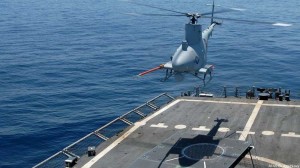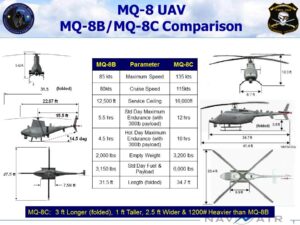Fire Scout Drone’s First At-Sea Takeoff
Posted on
Fire Scout makes it look easy to take off from a destroyer. It’s not.
In video released today (above), the MQ-8C helicopter takes off from the destroyer Jason Dunham with its eyes closed — or rather with its cockpit windows painted over, because there’s nobody inside. Though derived from the widespread Bell 407, the Northrop Grumman MQ-8C is a drone. This month’s tests are the first time the unmanned helicopter has taken off from a Navy ship at sea, and the first time any unmanned helicopter of any kind has taken off from a destroyer. The earlier MQ-8B version of the Fire Scout has already seen service on Navy frigates and Littoral Combat Ships, but the C-model is a much bigger aircraft and the Jason Dunham is a much bigger vessel.

The smaller MQ-8B Fire Scout operating off a Navy frigate.
Launching from and landing on a ship is “the most challenging [flight] regime for a naval helicopter,” said Capt. Jeff Dodge, the Fire Scout program manager at the Naval Air Systems Command (NAVAIR). “The deck is moving, the wind is turbulent — it’s really hard to replicate that on land.”
Aircraft carriers are notoriously nightmarish to touch down on: Navy fighter pilots actually show higher stress levels in night landings than in combat, though the Navy’s taught an unmanned jet to do the job. But carriers have a big, flat deck to land on and a big, deep hull to keep them from rolling too much. Destroyers like the Dunham are much smaller, so they’re less stable and can only accommodate a helipad. What’s more, unlike the streamlined control tower (or “island”) mounted on one side of a carrier’s vast flight deck, a destroyer’s complex superstructure dominates its deck and creates unpredictable turbulence in the air passing over it, what’s called the ship’s “air wake.”

The older, smaller MQ-8B Fire Scout vs. the new and larger MQ-8C
Simulations are helpful, but, to quote one 2012 paper on the topic, “current computational methods are insufficiently validated for ships with a complex superstructure, such as a destroyer or cruiser” (i.e. opposed to a flattop). In other words, our current computer models can’t capture the chaotic interaction between most warships’ air wakes and a helicopter. That means real-life at-sea testing like the Fire Scout’s aboard the Dunham is essential — and you never really know how it will go until you actually do it.
In this case, Fire Scout did well: The take-off and landing on the video are the first of 22.
A note: The Jason Dunham is named in honor of a young Marine who died throwing himself on a grenade on Iraq, saving his comrades. He was awarded a posthumous Congressional Medal of Honor. I once had the honor to interview many of his fellow Marines. It’s good to see his ship at the cutting edge of Navy innovation.
Subscribe to our newsletter
Promotions, new products and sales. Directly to your inbox.
